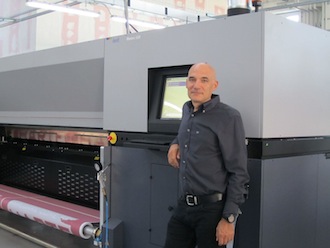Italian Web-to-print giant Pixartprinting has consolidated its relationship with Durst by taking a Rhotex inkjet printer for industrial soft signage applications.
“For a while we have been noticing clients’ shift in favour of textiles rather than standard PVC banners. The reasons for this are not surprising if we consider a number of unbeatable advantages. Firstly, disposal of materials if simpler than with standard PVC banners, lighter fabrics, easily foldable and transportable, less creasing and may be used number of times more than PVC banners”, said Alessandro Tenderini, Pixartprinting managing director.
“Our choice to go ‘green’ is not a fashion statement, but a necessity,” he added. “Many European countries are heavily regulated by Environmental laws which inevitably result in standard PVC materials being replaced by environmentally friendly textiles.”
Pixartprinting has more than 95,000 clients in Europe, and says that in order to supply growing demand and remain faithful to its short delivery times it relies on the productivity and reliability of Durst technology. The company was already the biggest Durst Rho P10 plant in the world, a relationship strengthened with the Rhotex.
“Textiles have been present in our range of products since 2007. In the last years, the demand has increased drastically, enough to require an additional production support. After a thorough research into it, Rhotex was the only system which matched our specific needs, such as ‘around the clock’ productivity, image quality, reliability and process automatisation. It is the only industrial printer in line with our demanding requirements,” said Tenderini.
The Rhotex prints up to 110m2/h, 600dpi, in six colours. It uses water-based dispersion inks that are recyclable, odourless and free of VOC's. Prints have two-years outdoor lifespan.
Alberto Bassanello, sales director for Durst Italy, said: “Witnessing Pixartprinting’s recent growth, we expect an immediate installation of a second Rhotex,” a prediction in line with Tenderini’s comment: “We are only at the beginning. Textile is still not fully discovered and may have its applications in many areas.”
Pixartprinting’s R&D department is currently looking into extending currently available textile range and its uses, with polyester finishing, as well as with the use of natural materials such as cotton or linen.
Tenderini added: “In Pixartprinting’s DNA there is print. We think that any material which can be printed on is worth looking into. We have sufficient amount of curiosity, determination, stability and know-how to experiment with new possibilities and pleasantly surprise our clients with the new and the original. We like to see ourselves as trendsetters and make available the most unusual and the most creative solutions to a vast range of clients with the additional touch of ‘green’, even in textiles”.


